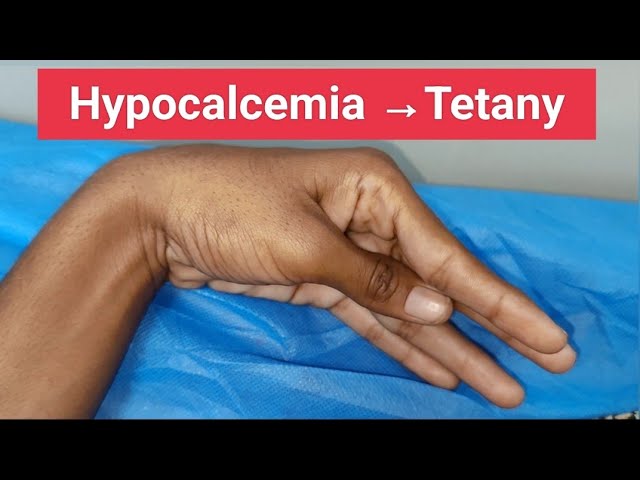Tetany refers to a medical condition characterized by involuntary muscle contractions, cramps, or spasms due to increased neuromuscular excitability. This physiological state is most commonly linked to electrolyte disturbances, particularly hypocalcemia, but can also be induced by alkalosis, hypomagnesemia, and other metabolic imbalances.
Prompt recognition and treatment of tetany are essential to prevent complications such as laryngospasm, seizures, and cardiac arrhythmias.

Causes of Tetany: Understanding the Underlying Triggers
1. Hypocalcemia (Low Serum Calcium Levels)
The most frequent cause of tetany is hypocalcemia, resulting in increased permeability of neuronal membranes to sodium ions, leading to spontaneous depolarizations and muscle spasms.
- Common causes of hypocalcemia:
- Hypoparathyroidism
- Vitamin D deficiency
- Chronic kidney disease
- Acute pancreatitis
- Post-thyroidectomy complications
2. Alkalosis
Respiratory or metabolic alkalosis causes calcium to bind to albumin more readily, reducing free ionized calcium, even if total calcium is normal.
3. Hypomagnesemia
Low magnesium impairs parathyroid hormone secretion and activity, contributing to secondary hypocalcemia.
4. Hypokalemia
Severe potassium deficiency can mimic tetanic symptoms due to changes in resting membrane potential.
5. Other Causes
- Hyperventilation syndrome
- Certain medications (e.g., loop diuretics, cisplatin)
- Malabsorption disorders
Clinical Manifestations of Tetany
1. Visible and Palpable Muscle Spasms
- Carpopedal spasm (involuntary contraction of hand and foot muscles)
- Facial twitching
- Laryngospasm (life-threatening in severe cases)
2. Latent Tetany (Subclinical Presentation)
Detected through elicitable signs even in absence of obvious spasms:
- Chvostek’s Sign: Facial twitch in response to tapping the facial nerve
- Trousseau’s Sign: Carpal spasm induced by inflating a blood pressure cuff above systolic pressure for 3 minutes
3. Neurological and Systemic Symptoms
- Paresthesia (tingling) in hands, feet, and perioral region
- Muscle stiffness
- Anxiety or restlessness
- Seizures (in prolonged or severe tetany)
Diagnosis of Tetany
Accurate diagnosis requires a comprehensive clinical evaluation and laboratory testing to confirm underlying causes.
Key Diagnostic Investigations:
| Test | Purpose |
|---|---|
| Serum Calcium | Detect hypocalcemia |
| Serum Magnesium | Evaluate coexisting hypomagnesemia |
| Serum Potassium | Rule out hypokalemia |
| Arterial Blood Gas (ABG) | Identify alkalosis |
| Parathyroid Hormone (PTH) | Determine cause of calcium imbalance |
| Vitamin D Levels | Assess deficiency status |
Electrocardiogram (ECG)
ECG findings may show QT interval prolongation, suggesting calcium imbalance and risk of arrhythmias.
Treatment of Tetany
Management depends on the severity of symptoms and underlying cause.
1. Acute Symptomatic Tetany
- Intravenous Calcium Gluconate: First-line treatment in emergencies
Dosage: 10 mL of 10% calcium gluconate over 10 minutes - Magnesium Sulfate IV: If associated hypomagnesemia is confirmed
- Airway Management: In cases of laryngospasm
2. Chronic or Recurrent Tetany
- Oral Calcium Supplements
- Vitamin D3 (Cholecalciferol) or Calcitriol
- Magnesium Supplementation (Oral/IV depending on severity)
- Parathyroid Hormone Therapy in hypoparathyroidism
Prevention Strategies for Tetany
Preventive measures focus on addressing nutritional and metabolic factors:
- Adequate dietary intake of calcium and vitamin D
- Regular monitoring in patients with chronic kidney disease or post-thyroid surgery
- Correction of electrolyte imbalances
- Avoidance of unnecessary hyperventilation
- Patient education on symptoms and early signs
Complications of Untreated or Recurrent Tetany
- Laryngospasm and airway obstruction
- Cardiac arrhythmias
- Chronic neuromuscular irritability
- Seizures
- Osteomalacia (with prolonged hypocalcemia)
- Psychiatric symptoms (e.g., irritability, depression)
Differential Diagnosis: Distinguishing Tetany from Other Conditions
It is vital to differentiate tetany from other disorders that cause similar symptoms:
| Condition | Distinguishing Features |
|---|---|
| Seizure Disorders | Loss of consciousness, EEG abnormalities |
| Dystonia | Twisting postures, no hypocalcemia |
| Hypokalemic Paralysis | Flaccid weakness, not spasms |
| Anxiety/Panic Attacks | Hyperventilation, subjective distress |
Early Recognition and Targeted Therapy for Tetany
Tetany is a clinical manifestation of underlying metabolic imbalances, predominantly hypocalcemia. Prompt recognition, immediate correction of biochemical abnormalities, and prevention of recurrence are essential to patient safety and well-being. Regular monitoring of electrolytes in at-risk populations and patient education significantly reduce morbidity associated with this condition.
Early intervention remains the cornerstone of successful management, ensuring full recovery and prevention of serious complications.

